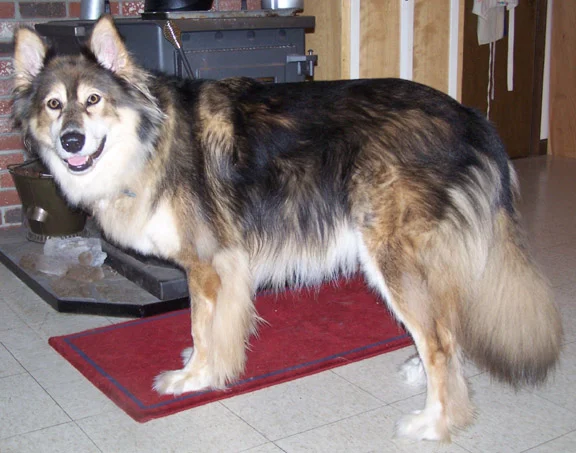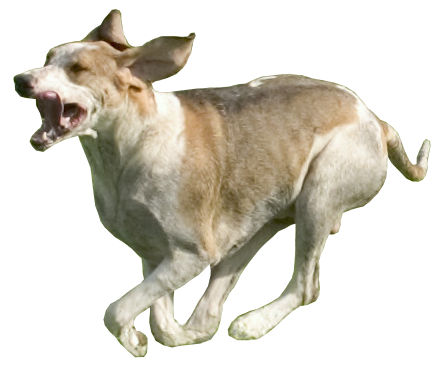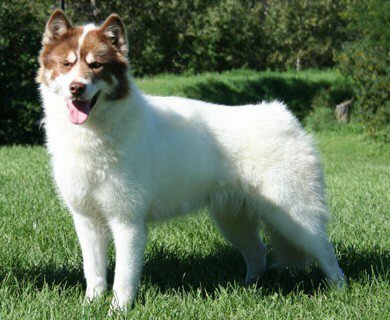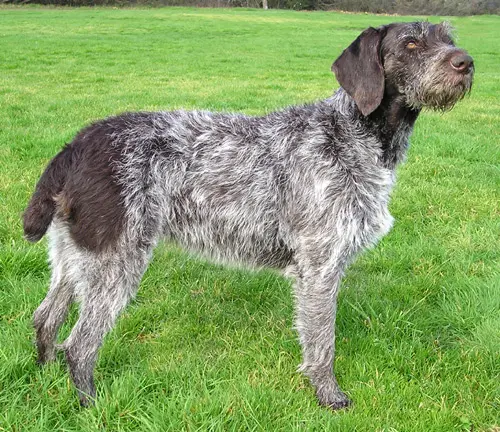Sakhalin Husky
The Sakhalin Husky, or Karafuto-ken, is a rare sled dog breed known for its loyalty and resilience. With a rich history tied to Japan's Antarctic expeditions, they require ample exercise and training to thrive.
Overview
🐕Breed Overview
✨Key Traits
💡What Makes Sakhalin Husky Special
The Sakhalin Husky is characterized by its remarkable endurance and strength, making it an excellent sled dog. They are highly social animals that enjoy the company of both humans and other dogs.
Their independent nature can sometimes lead to challenges in training, but with patience and positive reinforcement, they can learn effectively. Their history as working dogs means they have a strong instinct to pull and run, making them well-suited for activities like sledding and hiking.
Owners should be prepared for their energetic and playful personality, as they require regular physical and mental stimulation to prevent boredom.
The Sakhalin Husky, also known as the Karafuto-ken, is a rare and resilient breed with a rich history tied to Japan's northern regions. This spitz-type dog, closely related to the Akita Inu, was originally bred for sledding and hunting, showcasing remarkable endurance and strength. Standing between 22 to 26 inches tall and weighing 66 to 88 pounds, Sakhalin Huskies are well-built with a thick, double coat that protects them from harsh weather conditions.
Their ears are small and pointed, often slightly tilted forward, and they come in various colors, including russet-red and black. The breed's claim to fame is linked to the 1958 Japanese Antarctic expedition, where two Sakhalin Huskies, Taro and Jiro, survived for nearly a year after being left behind. Their incredible story of survival has been immortalized in Japanese culture, leading to a resurgence of interest in the breed.
Sakhalin Huskies are known for their friendly and loyal nature, making them excellent companions for active families. However, they require significant exercise and mental stimulation to thrive. Daily activities should include running, hiking, and engaging in dog sports to keep them happy and healthy.
Their strong prey drive and independent nature can pose training challenges, so early socialization and consistent training methods are essential. Despite their rarity, the Sakhalin Husky is a breed that embodies resilience, loyalty, and a deep connection to its historical roots. With proper care and attention, they can make loving and devoted companions for those who appreciate their unique heritage and active lifestyle.
🎉Fun Facts
Taro and Jiro, two Sakhalin Huskies, became national heroes in Japan after surviving for nearly a year in Antarctica after being left behind during an expedition.
The breed is known for its strong prey drive and may chase after small animals if not properly trained and socialized.
The Sakhalin Husky is one of the rarest dog breeds in the world, with only a few purebred individuals remaining.
Breed Characteristics
Family & Friends
Good Behavior
Get Up & Go
Household Harmony
Temperament & Personality
✨Key Traits
🐕Core Temperament
The Sakhalin Husky has a friendly and outgoing temperament, making them excellent companions for families. They are generally good with children and enjoy being part of family activities.
However, their independent streak can sometimes lead to stubbornness, requiring consistent training and socialization. They are protective of their families and can be wary of strangers, making them good watchdogs.
Their strong prey drive means they may chase after small animals, so supervision is necessary when interacting with other pets. Overall, they are affectionate, loyal, and energetic dogs that thrive in active households.
💫Personality Profile
Sakhalin Huskies are known for their loyal and affectionate nature, forming strong bonds with their families. They are energetic and require ample exercise to keep them happy and healthy.
While they can be independent and stubborn, they are also intelligent and capable of learning commands and tasks with consistent training. Their friendly demeanor makes them good companions for children, but their strong prey drive means supervision around smaller pets is necessary.
They thrive in active households where they can participate in outdoor activities and adventures.
🔊Vocal Tendencies
Sakhalin Huskies are known to be vocal dogs, often barking to communicate their needs or alert their owners to potential intruders. While they are not excessive barkers, they may vocalize more when bored or anxious.
Their barking can vary in tone and intensity, and they may also howl, especially if they hear other dogs or sirens. It's important for owners to provide adequate exercise and mental stimulation to minimize unnecessary barking and ensure a calm environment.
Affection & Social Traits
Energy & Activity
Communication Style
Care Requirements
🏃♂️Exercise Requirements
Daily Exercise
The Sakhalin Husky is a highly active breed that requires substantial daily exercise to maintain its physical and mental well-being. Ideally, they should engage in at least 90 minutes of vigorous activity each day.
This can include activities such as running, hiking, or pulling sleds, which cater to their natural instincts as sled dogs. Regular walks, play sessions, and opportunities for off-leash running in a secure area are essential to prevent boredom and destructive behaviors.
Puppies require shorter, more frequent exercise sessions to avoid overexertion, while senior dogs may benefit from gentler activities like leisurely walks or swimming. Insufficient exercise can lead to weight gain, anxiety, and behavioral issues, making it crucial for owners to prioritize their Sakhalin Husky's exercise needs.
Preferred Activities
🏠Living & Adaptability
Space Requirements
Sakhalin Huskies thrive in environments that provide ample space for exercise and exploration. They are best suited for homes with large yards or access to open areas where they can run freely.
While they can adapt to apartment living, it requires a dedicated commitment to daily exercise and mental stimulation. Owners in smaller living spaces should ensure their dog has regular access to parks or open fields.
The breed's size and energy levels necessitate a secure environment to prevent escape, as they are known for their strong prey drive and tendency to wander.
Climate Preference
🍲Feeding Guide
Schedule
Food Types
Portion Size
Special Nutritional Needs
Sakhalin Huskies may benefit from a diet rich in protein and healthy fats to support their active lifestyle. It's important to monitor their weight and adjust portions accordingly, especially during shedding seasons when their nutritional needs may change. Some individuals may have food sensitivities, so it's advisable to consult with a veterinarian for personalized dietary recommendations.
✨Grooming Requirements
Grooming Overview
The Sakhalin Husky has a thick double coat that requires regular grooming to keep it healthy and free of mats. During shedding seasons, which typically occur in spring and fall, daily brushing is recommended to manage loose hair and prevent matting.
Use a slicker brush or an undercoat rake to effectively remove dead hair from the undercoat. Bathing should be done as needed, usually every few months, to maintain coat cleanliness without stripping natural oils.
Regular nail trimming and ear cleaning are also essential to ensure overall hygiene.
Care Schedule
Brush 2-3 times a week; daily during shedding seasons; bathe every 2-3 months; trim nails every 2-4 weeks.
Health Profile
⚕️Health Care
Regular veterinary care is essential for maintaining the Sakhalin Husky's health and longevity. Routine check-ups, vaccinations, and preventive treatments can help detect and address health issues early.
Owners should also be proactive in monitoring their dog's weight, dental health, and overall condition. Providing a balanced diet, regular exercise, and mental stimulation can significantly impact their quality of life and lifespan.
Health Issues Overview
⏳Average Lifespan
Genetic Factors
Genetics play a significant role in the Sakhalin Husky's lifespan, with certain hereditary health issues affecting their longevity. Responsible breeding practices that prioritize genetic diversity can help reduce the risk of inherited conditions.
Potential owners should seek reputable breeders who conduct health testing on their breeding stock to ensure the best chances for a healthy puppy. Understanding the breed's genetic predispositions can help owners make informed decisions regarding care and health management.
Living Conditions
The Sakhalin Husky's lifespan can be influenced by various environmental factors, including housing conditions, climate, and social interactions. They thrive in cooler climates and require ample outdoor space for exercise.
A secure yard or access to open areas is essential to prevent escape and ensure their safety. Regular social interactions with humans and other dogs are crucial for their mental well-being.
A stimulating environment that includes physical activity and mental challenges can contribute to a longer, healthier life.
🏥Common Health Issues
Hip Dysplasia
Warning Signs
🔬Diagnosis
X-ray examination by a veterinarian.
💊Treatment
Weight management, pain relief medications, and in severe cases, surgical intervention.
📝Management Tips
Maintain a healthy weight, provide joint supplements, and avoid excessive jumping or strenuous activities.
Progressive Retinal Atrophy (PRA)
Warning Signs
🔬Diagnosis
Veterinary eye examination.
💊Treatment
No cure; supportive care and environmental modifications.
📝Management Tips
Regular eye check-ups and monitoring for vision changes.
Hypothyroidism
Warning Signs
🔬Diagnosis
Blood tests to measure thyroid hormone levels.
💊Treatment
Thyroid hormone replacement therapy.
📝Management Tips
Lifelong medication and regular monitoring of thyroid levels.
🛡️Preventive Care
🔬Hip Evaluation
Evaluates the dog's hip joints for dysplasia and other abnormalities, crucial for preventing joint issues.
📅 Annually after 2 years of age.
🔬Thyroid Function Test
Checks for thyroid hormone levels to detect hypothyroidism, which can affect energy levels and overall health.
📅 Every 1-2 years, or as recommended by a veterinarian.
🔬Ophthalmic Examination
A comprehensive eye exam to identify any hereditary eye conditions, including PRA and cataracts.
📅 Every 1-2 years, especially for breeding dogs.
Training
🧠Intelligence & Trainability
💪Work Drive
Sakhalin Huskies have a strong work drive and thrive when given tasks to complete. Activities such as sledding, weight pulling, and agility training can provide the mental and physical stimulation they need.
Engaging them in dog sports or training for specific tasks can help fulfill their need for purpose and prevent boredom. Without adequate mental stimulation, they may resort to destructive behaviors, making it essential for owners to provide regular challenges and activities.
⚠️Training Considerations
Sakhalin Huskies can exhibit stubbornness and independence, which may pose challenges during training. They require consistent, positive reinforcement methods to encourage obedience.
Common behavioral issues include digging, excessive barking, and a strong prey drive, which can lead them to chase small animals. To mitigate these challenges, early socialization and training are essential.
Engaging them in mentally stimulating activities, such as puzzle toys or obedience training, can help channel their energy positively and reduce undesirable behaviors.
📝Training Tips
Training a Sakhalin Husky requires patience and consistency. Start with basic obedience commands and gradually introduce more complex tasks.
Use positive reinforcement techniques, such as treats and praise, to motivate them. Incorporating play into training sessions can keep them engaged and make learning enjoyable.
It's important to establish a routine and set clear boundaries to help them understand expectations. Socialization with other dogs and people from a young age is crucial to develop a well-rounded temperament.
History & Heritage
📜Origin Story
The Sakhalin Husky, also known as the Karafuto-ken, originates from Sakhalin Island in Japan. The breed was developed by the indigenous Ainu people, who relied on these dogs for sledding and hunting in the harsh northern climates.
The name 'Karafuto' refers to the Japanese name for Sakhalin, while 'ken' means dog in Japanese. The breed's historical significance was amplified during the 1958 Antarctic expedition, where Taro and Jiro became symbols of survival and loyalty after being stranded for nearly a year.
Their story has been immortalized in Japanese culture, leading to a resurgence of interest in the breed.
⏳Development History
The Sakhalin Husky is believed to be a precursor to the Akita Inu, developed in Japan for sledding and hunting purposes. The breed's history is closely tied to the indigenous people of Sakhalin Island, where they were utilized for transportation and as working dogs.
Over time, the breed's characteristics were refined through selective breeding, resulting in the modern Sakhalin Husky. However, the breed faced significant challenges during and after World War II, leading to a drastic decline in population and the near extinction of purebred lines.
Today, efforts are being made to preserve and promote the breed, but it remains rare.
🛡️Purpose & Historical Role
Originally bred for sledding and hunting, the Sakhalin Husky played a crucial role in transportation across the snowy terrains of Sakhalin Island. The breed was utilized by the Ainu people and later by Japanese researchers during expeditions to Antarctica.
Their endurance and strength made them ideal sled dogs, capable of pulling heavy loads over long distances. The breed's historical significance was further solidified by the tale of Taro and Jiro, who became national heroes after their survival story captured the public's imagination.
🏺Cultural Significance
The Sakhalin Husky holds a unique place in Japanese culture, particularly due to its historical connection to the Antarctic expeditions. The breed gained fame after the 1958 Japanese Antarctic expedition, where two Sakhalin Huskies, Taro and Jiro, survived for nearly a year after being left behind.
Their story of resilience captured the hearts of many and led to increased interest in the breed. Monuments commemorating the dogs and the expedition can be found in various locations in Japan, highlighting their importance in Japanese history and culture.
The breed's legacy continues to be celebrated through films and dramas that depict their heroic tale.
Conservation Status
This breed is endangered with low population numbers globally.









